Development and design
After the failure of the two-seat version of the Bristol Bullfinch, the requirement remained for an aircraft for the Royal Air Force to replace the Bristol F.2 Fighter. The Air Ministry therefore issued Specification 3/22 in 1922 for a two-seat fighter powered by a supercharged engine. Bristol's chief designer, Wilfred Reid (who had replaced Frank Barnwell when Barnwell emigrated to Australia), designed the Bristol Type 84 Bloodhound to meet this requirement, with Bristol deciding to build a prototype as a private venture. [1]
The Bloodhound was a two-seat biplane with swept two-bay wings, powered by a Bristol Jupiter IV radial engine. It first flew at the end of May 1923. [1] It was redesigned with a lengthened fuselage and revised wings when Frank Barnwell returned from Australia to resume his role as chief designer. The Air Ministry placed an order for three Bloodhounds to a revised specification (22/22), of which one was of all-metal construction and the other two fitted with wooden wings, [2] the first of these flying on 4 February 1925. After evaluation by the Aeroplane and Armament Experimental Establishment at RAF Martlesham Heath and Farnborough, it was clear that the Bloodhound was not adequate for the role of replacing the F.2. The other aircraft being evaluated against the specification to replace the F.2 in the reconnaissance role, the Hawker Duiker, Armstrong Whitworth Wolf and de Havilland D.H.42 Dormouse, were also found lacking.
The first prototype was fitted with a new Jupiter V engine, and received a civil certificate of airworthiness before being flown in the 1925 King's Cup air race. It was then fitted with a Jupiter VI engine and long-range fuel tanks as an engine testbed, [3] proving the reliability of the Jupiter for Imperial Airways [1] before finally being scrapped in 1931.

The Hawker Harrier was an experimental biplane torpedo bomber aircraft built by Hawker Aircraft to a specification issued in the 1920s for the RAF.

The Bristol Bulldog is a British Royal Air Force single-seat biplane fighter designed during the 1920s by the Bristol Aeroplane Company. More than 400 Bulldogs were produced for the RAF and overseas customers, and it was one of the most famous aircraft used by the RAF during the inter-war period.

The Boulton Paul P.29 Sidestrand was a twin-engine biplane medium bomber of the Royal Air Force. Designed for daylight operations, it was manoeuvrable and provided with three defensive gun positions. Named after a village on the Norfolk coast near Boulton & Paul's factory in Norwich, the Sidestrand first flew in 1926 and entered service in 1928. It remained in service until 1936, equipping No. 101 Squadron RAF. It was an agile and relatively fast aircraft that was capable of aerobatic manoeuvres such as loops, rolls and spins.

The Hawker Hedgehog was a three-seat reconnaissance biplane, to be used for naval scouting, produced to meet Air Ministry Specification 37/22.

The Short Springbok was a two-seat, all-metal reconnaissance biplane produced for the British Air Ministry in the 1920s. All together six aircraft of the Springbok design were built but none entered service with the armed forces.

The Armstrong Whitworth A.W.14 Starling was a prototype British single-seat biplane fighter developed for the Royal Air Force in the late 1920s which unsuccessfully competed against the Bristol Bulldog.

The Vickers Type 143 or Bolivian Scout was a British single-seat fighter biplane designed and built by Vickers in 1929-1930. Six were built for Bolivia in 1930, which used the survivors in the Chaco War against Paraguay.
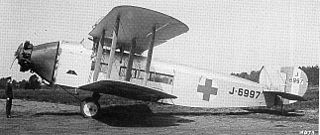
The Bristol Ten-seater and Bristol Brandon were British single-engine biplane transport aircraft built by the Bristol Aeroplane Company in the early 1920s. Only three were built, two of which were used as civil transports and one of which served with the Royal Air Force.

The Parnall Plover was a British single-seat naval fighter aircraft of the 1920s. Designed and built by George Parnall & Co. for use on Royal Navy aircraft carriers, it was ordered into small-scale production but after extensive evaluation, the Fairey Flycatcher was preferred for large-scale service.

The Bristol Boarhound was a British army cooperation and liaison aircraft of the 1920s. It was a two-seat biplane with wings of equal span, of steel frame construction with fabric covering.
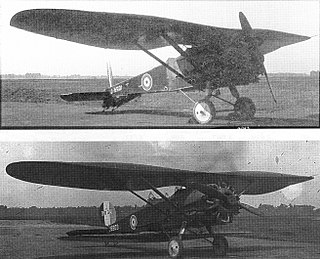
The Bristol Bullfinch was an experimental British military aircraft first flown in 1922. Variants were built as both parasol wing monoplanes and biplanes, but both versions proved unsuccessful, and only the three prototypes were built.
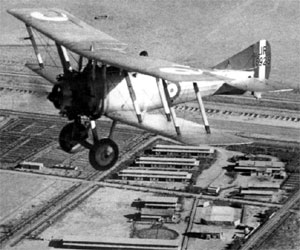
The Nieuport Nighthawk was a British fighter aircraft developed by the Nieuport & General Aircraft company for the Royal Air Force towards the end of the First World War. Although ordered into production before the aircraft first flew, it did not enter large scale service with the RAF owing to unreliable engines. Re-engined aircraft did see service in Greece, serving from 1923 to 1938.
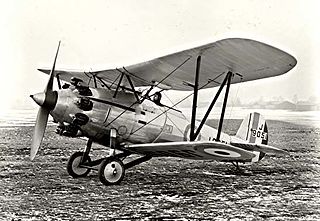
The Bristol Type 107 Bullpup was a British fighter aircraft built in the 1920s. It was not selected for squadron service and only the single prototype was built

The Bristol Bagshot, also known as the Type 95, was a prototype heavily armed British fighter built by the Bristol Aeroplane Company and first flown in 1927. Flight testing revealed serious problems, and the project was abandoned.

The Bristol Badger was designed to meet a British need for a two-seat fighter-reconnaissance aeroplane at the end of World War I. Despite the 1918 Armistice, three Badgers were delivered to the Air Board to develop air-cooled radial engines, particularly that which became the Bristol Jupiter; two other Badgers were also built.

The Westland Weasel was a prototype British two-seat fighter/reconnaissance aircraft of the First World War. Designed to replace the Bristol Fighter, the Weasel was a single engined tractor biplane. Four prototypes were built, but no production followed owing to the failure of its original engine, although the prototypes were used as engine test beds for the successful Armstrong Siddeley Jaguar and Bristol Jupiter engines.
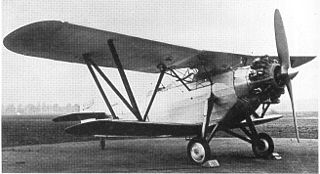
The Bristol Type 118 was a general-purpose military aircraft, a two-seat biplane built by the Bristol Aeroplane Company in the early 1930s, powered by a Bristol Mercury radial engine and aimed at overseas markets. The Type 120 was a Bristol Pegasus-engined variant entered into an Air Ministry competition and later used for armament tests. Two aircraft were built.

The Bristol Type 146 was a British single-seat, eight-gun fighter monoplane prototype built to a mid-1930s Air Ministry contract. Powered by a radial engine, it was outclassed by Merlin-engined fighters and only one was built.
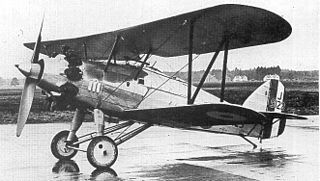
The Hawker F.20/27 was a British fighter design built to an Air Ministry specification for an interceptor in the late 1920s. It was a single-seat biplane powered by a radial engine; the very similar but V-12-engined Hawker Fury development proved superior and only one F.20/27 was built.
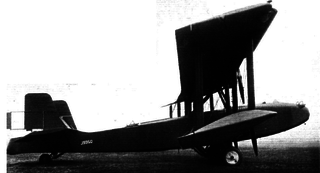
The sole Boulton & Paul P.32 was a British three-engined biplane built to an Air Ministry specification for a long range night bomber. A lack of engine availability slowed construction and by the time it went for tests the thinking on bomber types had moved on.
This page is based on this
Wikipedia article Text is available under the
CC BY-SA 4.0 license; additional terms may apply.
Images, videos and audio are available under their respective licenses.




















